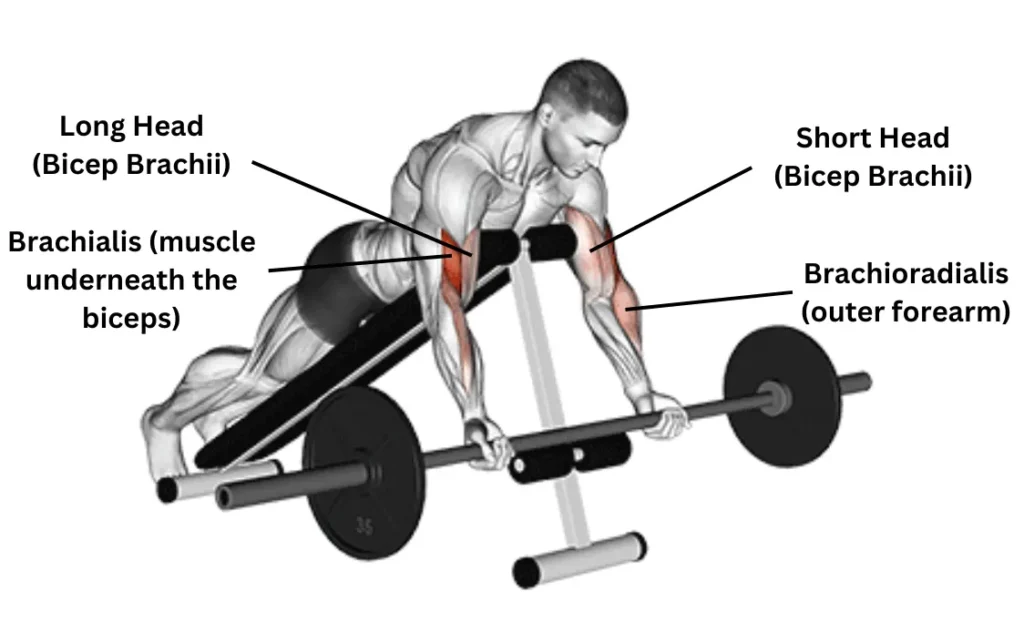In today’s day and age, the desire to sculpt impressive biceps transcends age boundaries.
From teenagers to middle-aged individuals, hitting the gym with the singular goal of looking bigger and stronger is commonplace. Yet, it becomes hard to find an exercise that suits one’s needs and is easy to execute, which can be challenging.
Enter the barbell spider curls—an exercise that ticks all the boxes and requires relatively minimal effort. With its gravitational movement, this exercise activates the biceps and helps with their growth and development.
With everything in mind and a bit of effort each day, you can make your arms look better than Superman.
Benefits of the Barbell Spider Curl
Barbell spider curl has earned its place on our best biceps exercise list without question.
Effective and requiring less effort to perform, they’re a favored choice among many. When an exercise delivers results with relative ease, there’s no reason to overlook it.
Isolate the Biceps Better
While many variations of biceps curls engage additional muscle groups alongside the biceps, this exercise takes it a step further.

By solely focusing on the short head of the biceps, it provides a great opportunity for targeted biceps development.
Requires Less Overall Body Work
The bench setup for spider curls indeed reduces strain on your body, making the exercise much more manageable.
By concentrating on lifting the bar, you primarily engage your upper body strength, allowing for a more focused contraction of the biceps without the distraction of overall body discomfort.
Stronger Elbow and Shoulder Joint
Shoulder and elbow pain is a common issue for people worldwide, often stemming from sports or fitness activities.(1)
Improving your joint strength can come in handy when lifting heavy weights or carrying heavy objects.
While spider curls can improve joint strength, it’s important to be mindful that improper execution of this exercise may lead to the opposite effect.
How to Do Barbell Spider Curl
- Set the bench between 45 and 60 degrees and lay face down on the bench.
- Now grab a barbell and place your hands about shoulder-width apart with your palm facing down.
- Lift the bar up fully and hold the bar for a few seconds, getting a good squeeze at the top.
- Lower the bar with controlled movement while keeping your elbows still.
Equipment: Standard Barbell
Primary Muscle Work: Short Head (Biceps Brachii)
Grip: Shoulder Width Apart
Barbell Spider Curl Tips
- Mind-Muscle Connection: Focus on contracting the biceps forcefully at the top of each repetition, emphasizing the squeeze to maximize muscle activation and growth.
- Mind Your Wrist Position: Pay attention to the alignment of your wrists during the exercise. Keep them straight and avoid excessive bending or cocking to prevent wrist strain.
- Mindful Descending: Lower the barbell with control and resist the urge to let it drop quickly. This maximizes muscle activation and reduces the risk of injury.
Common Mistakes
Common mistakes to avoid while performing the spider curls:
Lifting Too Heavy
It’s safe to say that spider curls can be easier to perform than regular barbell curls.
However, this doesn’t mean you should load the bar with excessive weights.
While you might succeed initially, over time, your muscles may struggle to keep up.
If you’re determined to lift heavier weights, consider implementing progressive overload techniques.
Improper Bench Positioning
The recommended bench position for spider curls is 45 degrees or anything between 45 and 60.
Bench position is important for proper muscle engagement and a comfortable workout experience.
If your bench isn’t set up properly, it can lead to instability, limited range of motion, incorrect muscle engagement, discomfort, pain, and decreased performance.
Using Momentum
Momentum can be beneficial for certain exercises, but not for spider curls.
Using momentum during spider curls reduces the isolation of the primary muscle, which is the biceps while activating other muscle groups.
This not only reduces the effectiveness of the exercise but also increases the risk of injury.
Focus on controlled movement for an effective and risk-free exercise experience.
Barbell Spider Curl Alternatives and Variation
There are numerous alternatives and variations to choose from, but here are the top picks recommended by our editor:
Dumbbell Spider Curl
Think of the dumbbell spider curl as a little brother of the barbell spider curl.
While both variations offer effective muscle targeting, the use of dumbbells introduces the potential for addressing muscle imbalances.
Since each arm works independently, one side may receive more activation than the other. But when you use the barbell, you lift it up with both hands parallel to each other, making both arms activate equally.
Barbell Preacher Curl
Barbell preacher curls offer an excellent alternative to spider curls, as they target similar muscle groups within the biceps.
Thanks to its preacher bench, preacher curls are easy to perform with less body effort as you can rest your upper body on the bench and perform the exercise.
EZ Bar Spider Curl
EZ bar spider curls present another effective alternative to barbell spider curls.
Simply switching equipment maintains the same exercise benefits.
The design of the bar makes it easier to use than a standard barbell. Its unique shape promotes a more comfortable and efficient execution of spider curls.
Final Thoughts
If you’re seeking an effective and straightforward exercise for your biceps, look no further than spider curls.
This exercise, performed on an incline bench, is perfect for building muscle mass and strength.
With the help of a barbell and bench, you can achieve the biceps you’re so desperate for.
References
- Li WH, Hadizadeh M, Yusof A, Naharudin MN. Analysis of Research Trends on Elbow Pain in Overhead Sports: A Bibliometric Study Based on Web of Science Database and VOSviewer. Healthcare (Basel). 2022 Nov 9;10(11):2242. Doi: 10.3390/healthcare10112242. PMID: 36360583; PMCID: PMC9690300.
Featured image by Jay Cutler/Instagram edited by SA